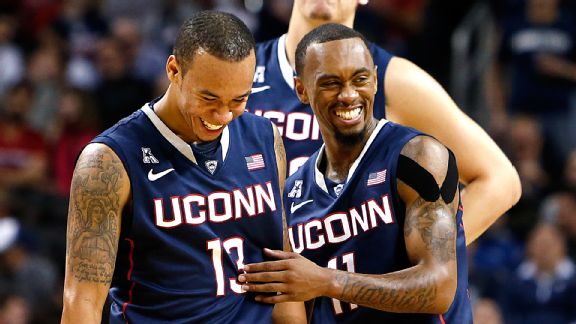UConn’s Statistical Profile Suggests a Correction is Coming, But How Far?
Posted by Bennet Hayes on December 19th, 2013Entering Wednesday night’s game against Stanford, it may have been easy for UConn fans to forget about “what could have been.” Because while snake-bitten teams like to dream about where they would be with a made shot here or a missed one there, the blessed teams inevitably fail to remember just how thin that line between winning and losing actually was. After all, a win is a win, right? Or in UConn’s case, nine wins was nine wins; hence the top 10 ranking and quickly escalating expectations. But if any Huskies – players, coaches or fans – forgot that their four best victories of the young season came by a total of five points, Wednesday night’s last-second loss surely reminded them that winning and losing can often look — if not feel — very similar. But should there be cause for concern in Storrs? Or would pressing the panic button make me us just as hyper-reactionary as those who anointed Shabazz Napier and company Final Four contenders after the win over Florida? Both are fair questions, but after a clunker of a second half turned in by the Huskies, I’m wondering just how much better this UConn team is than the last.

Thursday’s Loss To Stanford Notwithstanding, Shabazz Napier And Ryan Boatright Have Had A Lot To Laugh About So Far This Season. Do Tougher Times Lie Ahead For The Huskies?
Last season’s Huskies were far from bad. They went 20-10 (10-8 in the Big East), and finished 47th in KenPom’s final rankings. But much like the current UConn iteration, they didn’t enjoy taking care of business until the final seconds of the game – and often in the five minutes that followed. Kevin Ollie’s first team went 5-2 in overtime contests, and played a total of nine extra periods over the course of the season. Needless to say, their smoke and mirrors stuff didn’t just get started last month.
Last year’s encouraging season elicited hope that better days were ahead. Unfortunately, little besides the raw record has hinted that this team is prepared to reward that optimism. Production is actually down for a number of key regulars — most notably Ryan Boatright and Omar Calhoun. Boatright actually has a lower offensive rating this season than last, despite shooting an unsustainable 42 percent from three-point range so far (he nailed 33 percent last season). Calhoun’s drop-off has been far more precipitous; his points, rebounds, and assists per game are all down — as are his percentages from the field and three.
Not every player needs to improve statistically for a team to get better, but if we are looking for a fringe top 5o team to make a legitimate leap into the top 1o or 20 without adding any newcomers, it’s fair to expect a player or two to elevate their games. With the potential exception of Napier, who probably was better than you thought last season anyways (he ranked 196th nationally in offensive rating last season; 323rd so far this year), no other Husky has done that. DeAndre Daniels may still get there, but so far his rebounding is down and his scoring only marginally improved.
But none of that stands as the largest statistical cause for concern if you are a Connecticut fan. The Huskies are currently shooting 44.3 percent from three-point range, second best in the nation. Great! Well, with almost the EXACT same team a year ago, UConn shot just 34.0 percent from deep; then good for 157th nationally. What’s more, those Huskies didn’t rely as much on the three-ball as this team does. Three-pointers accounted for 27.3 percent of their field goal attempts last year; but that number has skyrocketed to 34.2 percent in 2013-14. Take a look at the individual splits. Napier is shooting 52 percent from distance. Daniels is at 43 percent, up 12 percentage points from a year ago. George Washington transfer Lasan Kromah has found his stroke in Storrs, making 8-of-16 attempts from deep after converting just 12-of-56 last season. Niels Giffey is shooting 66 percent from behind the arc. Yes, I’ll repeat: Niels Giffey is shooting 66 percent from behind the arc. If you like sustainability, or the 2013-14 UConn Huskies, you don’t like any of these numbers. Even if we allow for a summer of improving UConn shooters and a little variance, these percentages simply have to revert back to a far lower mean. And when they do, UConn will still be a team with no legitimate inside presence that struggles to make two-point field goals (48.8%) and rarely gets to the line (279th in the country in free throw attempted percentage). Not a great long-term scenario.
That prognosis may be a bit dire, but you get the picture. Offensively UConn will need to find some alternate solutions when the three stops dropping. The good news is that Kevin Ollie’s defense has been stout (12th nationally in defensive efficiency), and despite somewhat redundant skill sets, Napier and Boatright still form one of the better backcourts in the country. What’s more, Connecticut woke up Thursday as the #10 team in the country, and with just one loss to its name. Trust me when I say that things could be a lot worse.











































